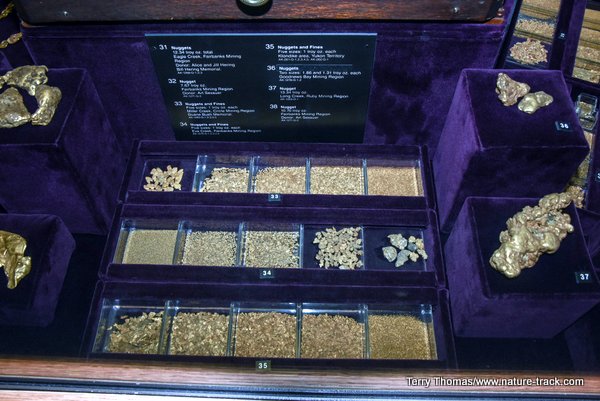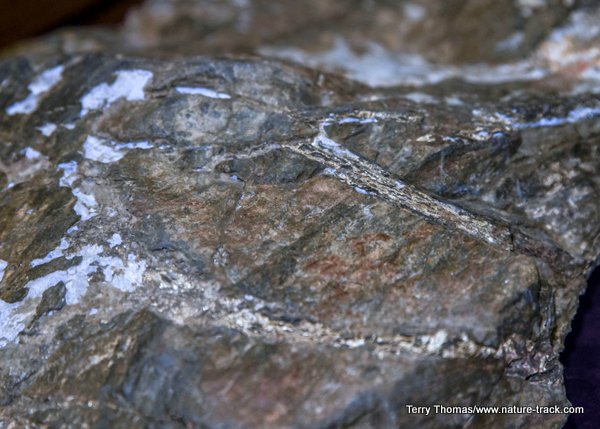Rock or Mineral


Left: gold nuggets of various sizes rest in velvet at the University of Alaska Museum.
Right: Gold seams and quartz can clearly be seen in this rock from the University of Alaska Museum.
I stared down into the gold-mining pan in my hands. After considerable consternation, I was finally able to swish out all the sand and water, and left there in the bottom of the pan were about a dozen tiny flakes of gold. Real, pure gold. When I weighed my bounty at Alaska’s Gold Dredge 8 near Fairbanks, I was told it was worth around $30.
Gold is one of about 5,400 substances recognized as minerals. We often use the words rock and mineral synonymously but they are not the same. Rock is defined by the process that makes it: igneous, metamorphic or sedimentary. A mineral, on the other hand, is defined by its unique crystalline structure and shape with repeating atomic arrangements. In other words, they have a specific chemical composition and structure that is always the same.
You can think of rocks as mineral compounds, composed of several to numerous minerals and/or containing seams of pure minerals. Rock can also be made from or contain organic remains as well. This makes minerals, not rocks, the true foundation of this planet.
That is not to say that minerals are not compounds. Some, such as gold and copper are elements: “a pure substance consisting only of atoms that all have the same numbers of protons in their nuclei” (Wikipedia). Most minerals though, are made from a mix of substances. Quartz, for instance, one of the most common minerals, is made from oxygen and silicon. Their atoms combine to form three-sided pyramids which stack on top of each other.
Concentrations are what make minerals economically valuable and a challenge to find. If all the gold in the world was spread out evenly over all land surfaces, it would be so diluted as to be impossible to extract economically. But when a concentration can be located and mined, it can be lucrative indeed.
Minerals can often form large deposits of pure or mostly pure mineral. These are known to have a, “restricted mode of incidence” or, aren’t found everywhere. While visiting the Kennecott Copper Mine in Wrangell-St. Elias National Park near Valdez, Alaska (same Kennicott Copper Company as in Utah, but someone spelled the name wrong), we were told that the copper deposits there were so abundant and pure that native Alaskans could just pluck pieces from the surface and hammer them into useful tools. Intense mining of the area finally reached the end of the copper concentrations until it wasn’t worth the cost of extraction.
The largest gold nugget ever found, named The Welcome Stranger, was discovered just below the surface in Australia in 1869. It weighs (it still exists) 173 pounds (estimated refined weight of pure gold: 156.6 pounds) and at today’s rate of gold, $1,764/troy ounce, has a value of almost $4.5 million. The largest nugget ever found in the United States (4th largest in the world) came from the Sierra Nevada mountains of California in 1869 and weighed 109.2 pounds.
Quartz, along with feldspars, olivine, mica and several other minerals are considered rock building minerals. Most rock contains large amounts of these minerals either singly or in combination and 95 percent of the crust of this planet is comprised of just ten minerals. Silicates and feldspars comprise over half of that with quartz, mica and carbonate minerals making up most of the rest. The remaining 5 percent are the other 5,000 minerals.
There is a corollary between finding minerals and how we treat our fellow human beings. Andrew Carnegie was once asked why he had so many millionaires (43) on his payroll. He answered, “When you work with people, it is a lot like mining for gold...when you mine for gold, you must literally move tons of dirt to find a single ounce of gold. However, you don’t go looking for the dirt, you look for the gold.” If we only see the dirt in strangers, neighbors, friends and family, we are going to miss a lot of gold.
Help Idaho Wildlife
When we traveled across the state in October 2017, we visited most of the Idaho Department of Fish and Game wildlife management areas. Most of the vehicles we saw using the wildlife management areas did not have wildlife plates. Buying wildlife plates is a great way for non-hunters and hunters alike to support wildlife-based recreation like birding.
C'mon folks, let's help Idaho's wildlife by proudly buying and displaying a wildlife license plate on each of our vehicles!
See below for information on Idaho plates. Most states have wildlife plates so if you live outside Idaho, check with your state's wildlife department or vehicle licensing division for availability of state wildlife plates where you live.
And tell them that you heard about it from Nature-track.com!

Wildlife License Plates
Great news! as of 2024, there are three NEW designs for license plates. They still are bluebird, cutthroat trout and elk, but they are beautiful.
Idaho Wildlife license plates provide essential funding that benefits the great diversity of native plants and wildlife that are not hunted, fished or trapped—over 10,000 species or 98% of Idaho’s species diversity. Game species that share the same habitats (such as elk, deer, antelope, sage-grouse, salmon, trout) also benefit from these specialty plates.
No state tax dollars are provided for wildlife diversity, conservation education and recreation programs. Neither are any revenues from the sale of hunting or fishing licenses spent on nongame species. Instead, these species depend on direct donations, federal grants, fundraising initiatives—and the Idaho Wildlife license plates.
Both my vehicles have Bluebird Plates. I prefer the bluebird because the nongame program gets 70 percent of the money from bluebird plates, but only 60 percent of the money from elk and trout plates - 10 percent of the money from elk plates supports wildlife disease monitoring and testing programs (to benefit the livestock industry) and 10 percent from cutthroat plates supports non-motorized boat access.
Incidentally, in 2014, the Idaho Legislature denied the Department of Fish and Game the ability to add new plates or even to change the name of the elk and cutthroat plates (very specific) to wildlife and fish plates, a move that would have allowed for changing images occasionally and generating more revenue. It would seem that they believe that we Idahoans don't want a well funded wildlife program.
I think it is time we let the Legislature know that Idahoan support wildlife funding and that we would like to see these generic plates come to fruition.

"WOW. What a phenomenal piece you wrote. You are amazing." Jennifer Jackson
That is embarrassing, but actually a fairly typical response to my nature essays. Since The Best of Nature is created from the very best of 16 years of these nature essays published weekly in the Idaho Falls Post Register (online readership 70,000), it is a fine read. It covers a wide variety of topics including humorous glimpses of nature, philosophy, natural history, and conservation. Readers praise the style, breadth of subject matter and my ability to communicate complex and emotional topics in a relaxed and understandable manner.
Everyone can find something to love in this book. From teenagers to octogenarians, from the coffee shop to the school room, these nature essays are widely read and enjoyed.
Some of the essays here are my personal favorites, others seemed to strike a chord with readers. Most have an important message or lesson that will resonate with you. They are written with a goal to simultaneously entertain and educate about the wonderful workings of nature. Some will make you laugh out loud and others will bring a tear to the eye and warm your heart.
Readers Write:
"You hit a home run with your article on, Big Questions in Nature. It should be required reading for everyone who has lost touch with nature...great job!" Joe Chapman
"We enjoyed your column, Bloom Where Planted. Some of the best writing yet. The Post Register is fortunate to have your weekly columns." Lou Griffin.
To read more and to order a copy, click here or get the Kindle version
Copies are also available at:
Post Register
Island Park Builders Supply (upstairs)
Barnes and Noble in Idaho Falls
Harriman State Park, Island Park
Museum of Idaho
Valley Books, Jackson Wyoming
Avocet Corner Bookstore, Bear River National Wildlife Refuge, Brigham City, Utah
Craters of the Moon National Monument Bookstore, Arco, Idaho